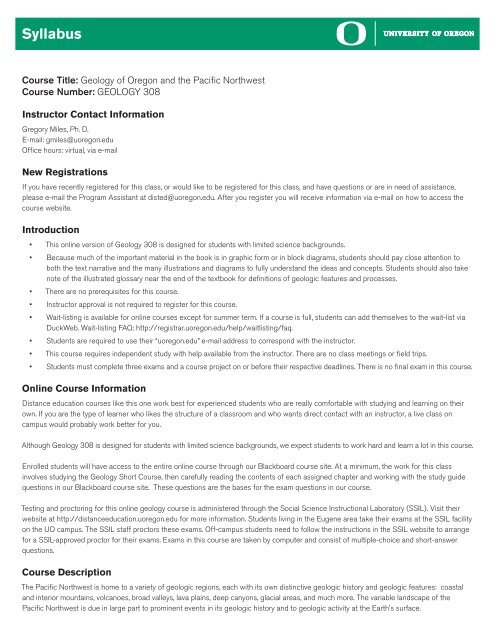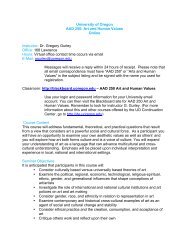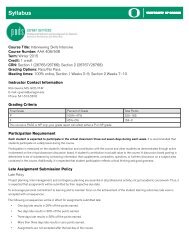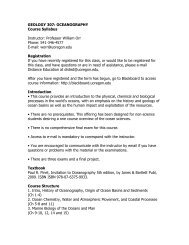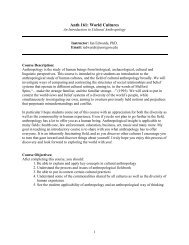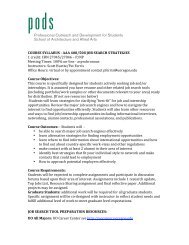Create successful ePaper yourself
Turn your PDF publications into a flip-book with our unique Google optimized e-Paper software.
<strong>Syllabus</strong><strong>Course</strong> Title: Geology <strong>of</strong> <strong>Oregon</strong> and the Pacific Northwest<strong>Course</strong> Number: GEOLOGY 308Instructor Contact InformationGregory Miles, Ph. D.E-mail: gmiles@uoregon.eduOffice hours: virtual, via e-mailNew RegistrationsIf you have recently registered for this class, or would like to be registered for this class, and have questions or are in need <strong>of</strong> assistance,please e-mail the Program Assistant at disted@uoregon.edu. After you register you will receive information via e-mail on how to access thecourse website.Introduction• This online version <strong>of</strong> Geology 308 is designed for students with limited science backgrounds.• Because much <strong>of</strong> the important material in the book is in graphic form or in block diagrams, students should pay close attention toboth the text narrative and the many illustrations and diagrams to fully understand the ideas and concepts. Students should also takenote <strong>of</strong> the illustrated glossary near the end <strong>of</strong> the textbook for definitions <strong>of</strong> geologic features and processes.• There are no prerequisites for this course.• Instructor approval is not required to register for this course.• Wait-listing is available for online courses except for summer term. If a course is full, students can add themselves to the wait-list viaDuckWeb. Wait-listing FAQ: http://registrar.uoregon.edu/help/waitlisting/faq.• Students are required to use their “uoregon.edu” e-mail address to correspond with the instructor.• This course requires independent study with help available from the instructor. There are no class meetings or field trips.• Students must complete three exams and a course project on or before their respective deadlines. There is no final exam in this course.Online <strong>Course</strong> InformationDistance education courses like this one work best for experienced students who are really comfortable with studying and learning on theirown. If you are the type <strong>of</strong> learner who likes the structure <strong>of</strong> a classroom and who wants direct contact with an instructor, a live class oncampus would probably work better for you.Although Geology 308 is designed for students with limited science backgrounds, we expect students to work hard and learn a lot in this course.Enrolled students will have access to the entire online course through our Blackboard course site. At a minimum, the work for this classinvolves studying the Geology Short <strong>Course</strong>, then carefully reading the contents <strong>of</strong> each assigned chapter and working with the study guidequestions in our Blackboard course site. These questions are the bases for the exam questions in our course.Testing and proctoring for this online geology course is administered through the Social Science Instructional Laboratory (SSIL). Visit theirwebsite at http://distanceeducation.uoregon.edu for more information. Students living in the Eugene area take their exams at the SSIL facilityon the UO campus. The SSIL staff proctors these exams. Off-campus students need to follow the instructions in the SSIL website to arrangefor a SSIL-approved proctor for their exams. Exams in this course are taken by computer and consist <strong>of</strong> multiple-choice and short-answerquestions.<strong>Course</strong> DescriptionThe Pacific Northwest is home to a variety <strong>of</strong> geologic regions, each with its own distinctive geologic history and geologic features: coastaland interior mountains, volcanoes, broad valleys, lava plains, deep canyons, glacial areas, and much more. The variable landscape <strong>of</strong> thePacific Northwest is due in large part to prominent events in its geologic history and to geologic activity at the Earth’s surface.
Geology 308 begins with a short, but intensive study <strong>of</strong> basic geology using an online short course available in our Blackboard course site.This short course will enable students to understand many <strong>of</strong> the terms and concepts used in the textbook. Next, assigned readings fromthe textbook give students an overview <strong>of</strong> the geology <strong>of</strong> each <strong>of</strong> the major geologic regions <strong>of</strong> the Pacific Northwest. Studies focus on thegeologic history, features, and events that make each region distinct.In addition to three proctored exams, this course requires a project in the form <strong>of</strong> an illustrated term paper, a web page, or a PowerPoint file.Each student chooses a project topic that deals with some aspect <strong>of</strong> Pacific Northwest Geology. See the short description below. Details <strong>of</strong>project completion are given in our Blackboard course site.<strong>Course</strong> ObjectivesThe principal objective <strong>of</strong> this course is to learn about the geologic features <strong>of</strong> the various regions <strong>of</strong> the Pacific Northwest and the processesby which they formed. To help in this endeavor, students will use the online Geology Short <strong>Course</strong> and the textbook to learn basic geologicconcepts and terms that they can apply to their studies <strong>of</strong> the Pacific Northwest.The objectives <strong>of</strong> this course also include learning about:a. large-scale movements <strong>of</strong> the outer “shell” <strong>of</strong> the earth that are responsible for the origin and spatial distribution <strong>of</strong> mountain ranges,chains <strong>of</strong> volcanoes, and other large features (we refer to these movements and their consequences, such as mountain building, as “platetectonics”);b. processes that form the igneous, sedimentary, and metamorphic rocks that make up the Pacific Northwest region, and the basicclassifications and the characteristics <strong>of</strong> the most common rock types in each category;c. ways that rock masses respond to forces within the earth by either bending (folding) or breaking (faulting);d. changes in the configuration <strong>of</strong> the earth’s surface caused by the weathering and erosion <strong>of</strong> rock;e. reconstructing the geologic history <strong>of</strong> an area by using geologic concepts to interpret past events and using the geologic time scale toestablish the chronological sequence <strong>of</strong> these events.TextbookOrr, Elizabeth, and Orr, William, Geology <strong>of</strong> the Pacific Northwest (2nd ed).Waveland Press, Long Grove, Illinois, 2006 re-issue, ISBN: 1-57766-480-9.Ordering Textbooks<strong>Course</strong> textbooks can be purchased at the UO bookstore in Eugene, either in-person or by placing an order for mail delivery. Questions orproblems can be directed to the course books manager, Bruce Lundy at either 541-346-4331 or blundy@uoregon.edu. You will need tomake your purchase with a credit card when requesting mail delivery.<strong>Course</strong> StructureThis course uses the Blackboard course management system. Access information will be e-mailed to students once they have registered forthe course. <strong>Course</strong> information and tools, including detailed Study Guides, are located in our Blackboard course website. For access-relatedquestions or help relating to the course website, contact the Academic Extension Program Assistant at disted@uoregon.edu.Part 1: Geology Short <strong>Course</strong>, Cornerstones <strong>of</strong> Pacific Northwest Geology, Cascade Range, and Klamath Mountains. The study guide forPart 1 is located in Unit 3 <strong>of</strong> our Blackboard course site.Readings for exam 1:Geology Short <strong>Course</strong> (online)Textbook chapters:1. Cornerstones <strong>of</strong> Pacific Northwest Geology4. Cascade Mountains (pages 73-78, 87-106, 109-112, only)5. Klamath MountainsPart 2: Blue Mountains, Central Idaho, Snake River Plain, Owyhee Uplands, and Basin and Range. The study guide for Part 2 is located inUnit 5 in our Blackboard course site.Readings for exam 2:
Textbook chapters:6. Blue Mountains7. Central Idaho (pages 165-175, only)8. Snake River Plain and Owyhee Uplands9. Basin and RangePart 3: Columbia River Plateau and Coast Province <strong>of</strong> <strong>Oregon</strong> and Washington. The study guide for Part 3 is located in Unit 7 <strong>of</strong> ourBlackboard course site.Readings for exam 3:Textbook chapters:10. Columbia River Plateau11. Coast Province <strong>of</strong> <strong>Oregon</strong> and WashingtonExaminationsThere are three separate exams, each covering roughly one-third <strong>of</strong> the text material. The second and third exams are not comprehensive,so each exam is a stand-alone test over the assigned portions <strong>of</strong> the textbook. Exams consist <strong>of</strong> multiple-choice and short-answer essayquestions. Exams must be completed in a 2-hour period.Exams will be taken at designated proctoring locations and are administered by the Social Science Instructional Laboratory (SSIL). See theirwebsite for instructions and to schedule exams, available at http://distanceeducation.uoregon.edu.Exam DeadlinesThere are three exams required over the course <strong>of</strong> term, and each must be completed by a given date. For a current list <strong>of</strong> exam deadlines,refer to the information in the Blackboard course site.Discussion ForumThis course uses the Blackboard course delivery system. Included as part <strong>of</strong> the course website is an interactive threaded discussion forum.<strong>Course</strong> Project• Each student will assemble a course project during the term. The project will consist <strong>of</strong> information pertaining to the course that hasbeen obtained from a variety <strong>of</strong> media sources. Each student will choose a topic from a list available in our Blackboard course site,research it online and/or in the library, and write a summary that captures the most essential ideas <strong>of</strong> the topic. Details <strong>of</strong> the project,both the written summary and the visuals, are up to the student’s own creativity.• The format <strong>of</strong> the project is up to the student. Three popular formats are 1) text with embedded illustrations, 2) a web page, and3) PowerPoint. No matter which format is chosen, the project must contain a summary <strong>of</strong> at least four net pages <strong>of</strong> text and at leastten illustrations to qualify for a B grade or higher.• Students should complete a computer-sensible form <strong>of</strong> their project and submit it to the instructor, using the directions in ourBlackboard course site.• Additional details pertaining to the project are given in the Blackboard site for this course.Grades<strong>Course</strong> Grades:Grades are available on Duck Web approximately the week after the last day <strong>of</strong> finals. Once grades become available, students needingtranscripts with current term grades may place an order with the Registrar in advance for mailing. Please refer to the “Transcripts” section <strong>of</strong>the Office <strong>of</strong> the Registrar’s website.Exam Grades:Grades for each exam are available upon submission <strong>of</strong> the exam, and may be reviewed by following the instructions in the Grading Policies/Exam Grades section <strong>of</strong> the syllabus in our Blackboard course site. The final grade will be determined as follows:1st exam: 30%2nd exam: 30%3rd exam: 20%<strong>Course</strong> project: 20%
Geology Short <strong>Course</strong>The Geology Short <strong>Course</strong> was prepared by Dr. Greg Miles. It provides general background information about the geologic sciences. Studentswho have not previously taken geology courses, or students who would like a review <strong>of</strong> general materials, would benefit from this summary.Exam 1 will include some questions from the Geology Short <strong>Course</strong>.Accessible Education CenterIf you have a documented disability and anticipate needing accommodations in this course, please contact a counselor in The AccessibleEducation Center. They are located in 164 <strong>Oregon</strong> Hall, Eugene, <strong>Oregon</strong>. Phone 541-346-1155. E-mail: uoaec@oregon.uoregon.edu.An equal-opportunity, affirmative-action institution committed to cultural diversity and compliance with the Americans with Disabilities Act. This publication will be made available in accessibleformats upon request. Accommodations for people with disabilities will be provided if requested in advance. © 2014 <strong>University</strong> <strong>of</strong> <strong>Oregon</strong>


